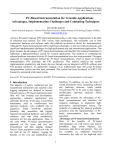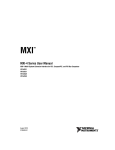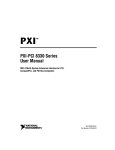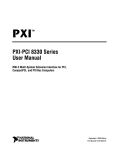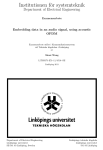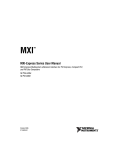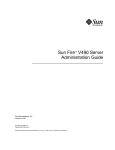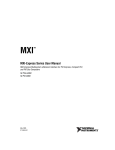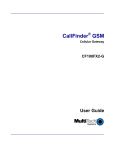Download National Instruments PCI-8336 User's Manual
Transcript
MXI TM MXI-4 Series User Manual MXI-4 Multi-System Extension Interface for PCI, CompactPCI, and PXI Bus Computers PCI-8331 PXI-8331 PCI-8336 PXI-8336 MXI-4 Series User Manual December 2003 Edition Part Number 370840A-01 Support Worldwide Technical Support and Product Information ni.com National Instruments Corporate Headquarters 11500 North Mopac Expressway Austin, Texas 78759-3504 USA Tel: 512 683 0100 Worldwide Offices Australia 1800 300 800, Austria 43 0 662 45 79 90 0, Belgium 32 0 2 757 00 20, Brazil 55 11 3262 3599, Canada (Calgary) 403 274 9391, Canada (Ottawa) 613 233 5949, Canada (Québec) 450 510 3055, Canada (Toronto) 905 785 0085, Canada (Vancouver) 514 685 7530, China 86 21 6555 7838, Czech Republic 420 224 235 774, Denmark 45 45 76 26 00, Finland 385 0 9 725 725 11, France 33 0 1 48 14 24 24, Germany 49 0 89 741 31 30, Greece 30 2 10 42 96 427, India 91 80 51190000, Israel 972 0 3 6393737, Italy 39 02 413091, Japan 81 3 5472 2970, Korea 82 02 3451 3400, Malaysia 603 9131 0918, Mexico 001 800 010 0793, Netherlands 31 0 348 433 466, New Zealand 0800 553 322, Norway 47 0 66 90 76 60, Poland 48 22 3390150, Portugal 351 210 311 210, Russia 7 095 783 68 51, Singapore 65 6226 5886, Slovenia 386 3 425 4200, South Africa 27 0 11 805 8197, Spain 34 91 640 0085, Sweden 46 0 8 587 895 00, Switzerland 41 56 200 51 51, Taiwan 886 2 2528 7227, Thailand 662 992 7519, United Kingdom 44 0 1635 523545 For further support information, refer to the Technical Support and Professional Services appendix. To comment on the documentation, send email to [email protected]. © 2003 National Instruments Corporation. All rights reserved. Important Information Warranty The PXI-PCI 8331 and 8336 hardware is warranted against defects in materials and workmanship for a period of one year from the date of shipment, as evidenced by receipts or other documentation. National Instruments will, at its option, repair or replace equipment that proves to be defective during the warranty period. This warranty includes parts and labor. The media on which you receive National Instruments software are warranted not to fail to execute programming instructions, due to defects in materials and workmanship, for a period of 90 days from date of shipment, as evidenced by receipts or other documentation. National Instruments will, at its option, repair or replace software media that do not execute programming instructions if National Instruments receives notice of such defects during the warranty period. National Instruments does not warrant that the operation of the software shall be uninterrupted or error free. A Return Material Authorization (RMA) number must be obtained from the factory and clearly marked on the outside of the package before any equipment will be accepted for warranty work. National Instruments will pay the shipping costs of returning to the owner parts which are covered by warranty. National Instruments believes that the information in this document is accurate. The document has been carefully reviewed for technical accuracy. In the event that technical or typographical errors exist, National Instruments reserves the right to make changes to subsequent editions of this document without prior notice to holders of this edition. The reader should consult National Instruments if errors are suspected. In no event shall National Instruments be liable for any damages arising out of or related to this document or the information contained in it. EXCEPT AS SPECIFIED HEREIN, NATIONAL INSTRUMENTS MAKES NO WARRANTIES, EXPRESS OR IMPLIED, AND SPECIFICALLY DISCLAIMS ANY WARRANTY OF MERCHANTABILITY OR FITNESS FOR A PARTICULAR PURPOSE. CUSTOMER’S RIGHT TO RECOVER DAMAGES CAUSED BY FAULT OR NEGLIGENCE ON THE PART OF NATIONAL INSTRUMENTS SHALL BE LIMITED TO THE AMOUNT THERETOFORE PAID BY THE CUSTOMER. NATIONAL INSTRUMENTS WILL NOT BE LIABLE FOR DAMAGES RESULTING FROM LOSS OF DATA, PROFITS, USE OF PRODUCTS, OR INCIDENTAL OR CONSEQUENTIAL DAMAGES, EVEN IF ADVISED OF THE POSSIBILITY THEREOF. This limitation of the liability of National Instruments will apply regardless of the form of action, whether in contract or tort, including negligence. Any action against National Instruments must be brought within one year after the cause of action accrues. National Instruments shall not be liable for any delay in performance due to causes beyond its reasonable control. The warranty provided herein does not cover damages, defects, malfunctions, or service failures caused by owner’s failure to follow the National Instruments installation, operation, or maintenance instructions; owner’s modification of the product; owner’s abuse, misuse, or negligent acts; and power failure or surges, fire, flood, accident, actions of third parties, or other events outside reasonable control. Copyright Under the copyright laws, this publication may not be reproduced or transmitted in any form, electronic or mechanical, including photocopying, recording, storing in an information retrieval system, or translating, in whole or in part, without the prior written consent of National Instruments Corporation. Trademarks LabVIEW™, MXI™, National Instruments™, NI™, ni.com™, and NI-VISA™ are trademarks of National Instruments Corporation. Product and company names mentioned herein are trademarks or trade names of their respective companies. Patents For patents covering National Instruments products, refer to the appropriate location: Help»Patents in your software, the patents.txt file on your CD, or ni.com/patents. WARNING REGARDING USE OF NATIONAL INSTRUMENTS PRODUCTS (1) NATIONAL INSTRUMENTS PRODUCTS ARE NOT DESIGNED WITH COMPONENTS AND TESTING FOR A LEVEL OF RELIABILITY SUITABLE FOR USE IN OR IN CONNECTION WITH SURGICAL IMPLANTS OR AS CRITICAL COMPONENTS IN ANY LIFE SUPPORT SYSTEMS WHOSE FAILURE TO PERFORM CAN REASONABLY BE EXPECTED TO CAUSE SIGNIFICANT INJURY TO A HUMAN. (2) IN ANY APPLICATION, INCLUDING THE ABOVE, RELIABILITY OF OPERATION OF THE SOFTWARE PRODUCTS CAN BE IMPAIRED BY ADVERSE FACTORS, INCLUDING BUT NOT LIMITED TO FLUCTUATIONS IN ELECTRICAL POWER SUPPLY, COMPUTER HARDWARE MALFUNCTIONS, COMPUTER OPERATING SYSTEM SOFTWARE FITNESS, FITNESS OF COMPILERS AND DEVELOPMENT SOFTWARE USED TO DEVELOP AN APPLICATION, INSTALLATION ERRORS, SOFTWARE AND HARDWARE COMPATIBILITY PROBLEMS, MALFUNCTIONS OR FAILURES OF ELECTRONIC MONITORING OR CONTROL DEVICES, TRANSIENT FAILURES OF ELECTRONIC SYSTEMS (HARDWARE AND/OR SOFTWARE), UNANTICIPATED USES OR MISUSES, OR ERRORS ON THE PART OF THE USER OR APPLICATIONS DESIGNER (ADVERSE FACTORS SUCH AS THESE ARE HEREAFTER COLLECTIVELY TERMED “SYSTEM FAILURES”). ANY APPLICATION WHERE A SYSTEM FAILURE WOULD CREATE A RISK OF HARM TO PROPERTY OR PERSONS (INCLUDING THE RISK OF BODILY INJURY AND DEATH) SHOULD NOT BE RELIANT SOLELY UPON ONE FORM OF ELECTRONIC SYSTEM DUE TO THE RISK OF SYSTEM FAILURE. TO AVOID DAMAGE, INJURY, OR DEATH, THE USER OR APPLICATION DESIGNER MUST TAKE REASONABLY PRUDENT STEPS TO PROTECT AGAINST SYSTEM FAILURES, INCLUDING BUT NOT LIMITED TO BACK-UP OR SHUT DOWN MECHANISMS. BECAUSE EACH END-USER SYSTEM IS CUSTOMIZED AND DIFFERS FROM NATIONAL INSTRUMENTS' TESTING PLATFORMS AND BECAUSE A USER OR APPLICATION DESIGNER MAY USE NATIONAL INSTRUMENTS PRODUCTS IN COMBINATION WITH OTHER PRODUCTS IN A MANNER NOT EVALUATED OR CONTEMPLATED BY NATIONAL INSTRUMENTS, THE USER OR APPLICATION DESIGNER IS ULTIMATELY RESPONSIBLE FOR VERIFYING AND VALIDATING THE SUITABILITY OF NATIONAL INSTRUMENTS PRODUCTS WHENEVER NATIONAL INSTRUMENTS PRODUCTS ARE INCORPORATED IN A SYSTEM OR APPLICATION, INCLUDING, WITHOUT LIMITATION, THE APPROPRIATE DESIGN, PROCESS AND SAFETY LEVEL OF SUCH SYSTEM OR APPLICATION. Compliance Compliance with FCC/Canada Radio Frequency Interference Regulations Determining FCC Class The Federal Communications Commission (FCC) has rules to protect wireless communications from interference. The FCC places digital electronics into two classes. These classes are known as Class A (for use in industrial-commercial locations only) or Class B (for use in residential or commercial locations). All National Instruments (NI) products are FCC Class A products. Depending on where it is operated, this Class A product could be subject to restrictions in the FCC rules. (In Canada, the Department of Communications (DOC), of Industry Canada, regulates wireless interference in much the same way.) Digital electronics emit weak signals during normal operation that can affect radio, television, or other wireless products. All Class A products display a simple warning statement of one paragraph in length regarding interference and undesired operation. The FCC rules have restrictions regarding the locations where FCC Class A products can be operated. Consult the FCC Web site at www.fcc.gov for more information. FCC/DOC Warnings This equipment generates and uses radio frequency energy and, if not installed and used in strict accordance with the instructions in this manual and the CE marking Declaration of Conformity*, may cause interference to radio and television reception. Classification requirements are the same for the Federal Communications Commission (FCC) and the Canadian Department of Communications (DOC). Changes or modifications not expressly approved by NI could void the user’s authority to operate the equipment under the FCC Rules. Class A Federal Communications Commission This equipment has been tested and found to comply with the limits for a Class A digital device, pursuant to part 15 of the FCC Rules. These limits are designed to provide reasonable protection against harmful interference when the equipment is operated in a commercial environment. This equipment generates, uses, and can radiate radio frequency energy and, if not installed and used in accordance with the instruction manual, may cause harmful interference to radio communications. Operation of this equipment in a residential area is likely to cause harmful interference in which case the user is required to correct the interference at their own expense. Canadian Department of Communications This Class A digital apparatus meets all requirements of the Canadian Interference-Causing Equipment Regulations. Cet appareil numérique de la classe A respecte toutes les exigences du Règlement sur le matériel brouilleur du Canada. Compliance with EU Directives Users in the European Union (EU) should refer to the Declaration of Conformity (DoC) for information* pertaining to the CE marking. Refer to the Declaration of Conformity (DoC) for this product for any additional regulatory compliance information. To obtain the DoC for this product, visit ni.com/hardref.nsf, search by model number or product line, and click the appropriate link in the Certification column. * The CE marking Declaration of Conformity contains important supplementary information and instructions for the user or installer. Contents About This Manual Conventions ...................................................................................................................vii Related Documentation..................................................................................................viii Chapter 1 Introduction About the MXI-4 Series.................................................................................................1-1 Description and Features .................................................................................1-1 Basic MXI-4 Systems......................................................................................1-2 Larger MXI-4 Systems ....................................................................................1-3 What You Need to Get Started ......................................................................................1-5 Unpacking ......................................................................................................................1-5 Chapter 2 Hardware and Software Installation Software Installation ......................................................................................................2-1 Hardware Installation.....................................................................................................2-2 Installing a PCI MXI-4 Card ...........................................................................2-2 Installing a PXI MXI-4 Card...........................................................................2-3 Cabling ............................................................................................................2-5 Powering Up the MXI-4 System .....................................................................2-6 Powering Down the MXI-4 System ................................................................2-6 Chapter 3 Hardware and Software Overview Hardware Overview .......................................................................................................3-1 Functional Overview .......................................................................................3-1 Functional Unit Descriptions...........................................................................3-2 National Instruments MXI-4 FPGA..................................................3-2 Parallel-to-Serial Converter ..............................................................3-2 Serial-to-Parallel Converter ..............................................................3-2 Serial Connector/Fiber Optic Transceiver ........................................3-2 MXI-4 Cable Options ......................................................................................3-3 Software Configuration..................................................................................................3-3 MXI-4 Retransmit Count.................................................................................3-3 MXI-4 Linked Chassis Status..........................................................................3-6 © National Instruments Corporation v MXI-4 Series User Manual Contents Appendix A Specifications Appendix B Common Questions Appendix C Technical Support and Professional Services Glossary Index MXI-4 Series User Manual vi ni.com About This Manual This manual describes the features, functions, and operation of the MXI-4 series of products. The four products in this series are the PCI-8331, PXI-8331, PCI-8336, and PXI-8336. The PXI-PCI 8331 and 8336 incorporate MXI-4 technology, which couples two physically separate PCI, CompactPCI, or PXI buses with a data link capable of 1.5 Gbit/s serial data rates. Conventions The following conventions appear in this manual: This icon denotes a note, which alerts you to important information. This icon denotes a caution, which advises you of precautions to take to avoid injury, data loss, or a system crash. bold Bold text denotes items that you must select or click in the software, such as menu items and dialog box options. Bold text also denotes parameter names. italic Italic text denotes variables, emphasis, a cross reference, or an introduction to a key concept. This font also denotes text that is a placeholder for a word or value that you must supply. monospace Text in this font denotes text or characters that you should enter from the keyboard, sections of code, programming examples, and syntax examples. This font is also used for the proper names of disk drives, paths, directories, programs, subprograms, subroutines, device names, functions, operations, variables, filenames and extensions, and code excerpts. MXI-4 card MXI-4 card refers to any of the following cards, unless otherwise noted: PCI-8331, PXI-8331, PCI-8336, and PXI-8336. MXI-4 dyad MXI-4 dyad refers to any of the following 4 pairs of MXI-4 cards: • PCI-8331 and PXI-8331 • PCI-8336 and PXI-8336 • PXI-8331 and PXI-8331 • PXI-8336 and PXI-8336 © National Instruments Corporation vii MXI-4 Series User Manual About This Manual In this manual, whenever a PXI chassis is referenced, a CompactPCI chassis could be used instead. Note Related Documentation The following documents contain information that you might find helpful as you read this manual: MXI-4 Series User Manual • Set Up Your MXI-4 System • Your computer or chassis documentation • PXI Hardware Specification, Revision 2.1 • PXI Software Specification, Revision 2.1 • PCI Specification, Revision 2.2 • PCI-PCI Bridge Architecture Specification, Revision 1.0 • PICMG CompactPCI 2.0 R2.1 specification viii ni.com 1 Introduction This chapter describes the MXI-4 series of products, lists what you need to get started, and explains how to unpack and set up your hardware. The four products in this series are the PCI-8331, PXI-8331, PCI-8336, and PXI-8336. For the remainder of this manual the term MXI-4 card will refer to any of the products in the MXI-4 series. MXI-4 cards must always be installed as either a pair of PXI cards or as a PCI card and a PXI card. The term MXI-4 dyad will refer to one of the four allowable pairings of MXI-4 cards which are described in the Conventions section of the About This Manual. About the MXI-4 Series Description and Features A MXI-4 dyad is a PCI master/slave implementing the PCI-PCI bridge register set. It couples two physically separate buses with either a copper or fiber-optic data link capable of 1.5 Gbit/s serial data rates. With the MXI-4 dyad, you can do the following: • Control a PXI/CompactPCI backplane with a PCI based PC • Control a PXI/CompactPCI backplane with another PXI/CompactPCI system • Increase the available number CompactPCI or PXI slots for your application • Physically separate the measurement or automation system from a host PC • Combine PCI, CompactPCI, and PXI devices in the same system © National Instruments Corporation 1-1 MXI-4 Series User Manual Chapter 1 Introduction Basic MXI-4 Systems MXI-4 cards are used in two basic configurations, both of which are shown in Figure 1-1: • A PCI MXI-4 in a PC, connected to a PXI MXI-4 in the controller slot of a PXI/CompactPCI chassis. • A PXI MXI-4 in a non-controller slot of a PXI/CompactPCI chassis with an embedded controller, connected to a PXI MXI-4 in the controller slot of another PXI/CompactPCI chassis. The PXI MXI-4 is capable of automatically detecting whether it is in a controller or non-controller slot and configuring itself accordingly. Note PC to PXI/CompactPCI PXI/CompactPCI to PXI/CompactPCI Figure 1-1. Basic MXI-4 Configurations MXI-4 Series User Manual 1-2 ni.com Chapter 1 Introduction Larger MXI-4 Systems Using multiple MXI-4 dyads, large PCI/PXI/CompactPCI systems can be created. The PCI specification makes provisions for up to 255 bus segments to simultaneously exist in a PCI hierarchy and MXI-4 hardware provides everything needed to support those provisions. Notes Keep in mind that some chassis and PCs have more than one PCI bus segment. The host configuration software (BIOS and OS) and device drivers must support the number of bus segments and PCI devices that you intend to use. Figure 1-2 shows how MXI-4 cards can be used to connect multiple expansion chassis to a PC in both a star and daisy chain topology. The PC that is shown at the root of the PCI hierarchy in this example could instead be a PXI/CompactPCI chassis with an embedded controller in its controller slot. The star topology will give higher performance than the daisy chain because it minimizes the number of MXI-4 dyads between the expansion cards and the PC. © National Instruments Corporation 1-3 MXI-4 Series User Manual Chapter 1 Introduction Daisy-Chain Configuration Star Configuration Figure 1-2. Star and Daisy Chain MXI-4 Configurations Adding PCI bridges, such as MXI-4, to a system can create a slight decrease in performance when communicating with devices behind the bridges. Note Although the distance between individual chassis is confined to a maximum of 10 meters for copper cables and 200 meters for fiber-optic cables, there is no limit to the total amount of cable in the system. MXI-4 Series User Manual 1-4 ni.com Chapter 1 Introduction What You Need to Get Started To set up and use your MXI-4 cards, you need the following: ❑ Two MXI-4 cards of the allowable pairings that comprise a MXI-4 dyad. The allowable pairings are: • PCI-8331 and PXI-8331 • PCI-8336 and PXI-8336 • PXI-8331 and PXI-8331 • PXI-8336 and PXI-8336 ❑ A MXI-4 cable • A copper cable for 8331 dyads • A fiber optic cable for 8336 dyads ❑ A host—This can be a PC with PCI slots, or a PXI/CompactPCI chassis that already has a controller ❑ An expansion chassis—This is the PXI/CompactPCI chassis that you control with the MXI-4 dyad ❑ NI MXI-4 software Note Your PXI MXI-4 card will work in any standard CompactPCI chassis adhering to the PICMG CompactPCI 2.0 R2.1 specification, or in PXI chassis that are compatible with the PXI Hardware Specification, Revision 1.0 or later. Your PCI MXI-4 card will work in systems compliant with the PCI Specification, Revision 2.2 or later. Unpacking Your MXI-4 cards are shipped in antistatic packages to prevent electrostatic damage (ESD) to the devices. ESD can damage several components on the device. Caution Never touch the exposed pins of connectors. Doing so may damage the device. © National Instruments Corporation 1-5 MXI-4 Series User Manual Chapter 1 Introduction To avoid such damage in handling the device, take the following precautions: • Ground yourself using a grounding strap or by holding a grounded object. • Touch the antistatic package to a metal part of the computer chassis before removing the device from the package. Remove the device from the package and inspect the device for loose components or any sign of damage. Notify NI if the device appears damaged in any way. Do not install a damaged device into the computer. Store the device in the antistatic envelope when not in use. MXI-4 Series User Manual 1-6 ni.com Hardware and Software Installation 2 This chapter explains how to install the MXI-4 software and hardware. Software Installation The software for your MXI-4 controller enables use of the MXI-4 Connection Monitor which is built into the MXI-4 hardware. This software enhances the product, allowing you to monitor your MXI-4 link, view information about the organization of your PXI system, and programmatically retrieve data about the link, chassis, and modules you have installed. The MXI-4 software for Microsoft Windows operating systems is included as part of NI-VISA. The appropriate version of NI-VISA is provided on the MXI-4 Software CD or National Instruments Driver CD included with your kit. To install the software, insert the CD into your computer and run the setup.exe program if it does not start automatically. Follow the installation program prompts to install the NI-VISA software and any other components you select. After installation you may be required to reboot your computer before using the MXI-4 software. If the MXI-4 software does not support your operating system, the operating system will provide a mechanism for you to ignore the MXI-4 Connection Monitor which is built into the MXI-4 hardware. Note If you are using LabVIEW Real-Time, be sure you also update the LabVIEW RT controller by accessing the Software attributes of your target system in Measurement & Automation Explorer (MAX) and using MAX to update the software on your LabVIEW RT controller. © National Instruments Corporation 2-1 MXI-4 Series User Manual Chapter 2 Hardware and Software Installation Hardware Installation The following are general instructions for installing the MXI-4 cards. Consult your computer user manual or technical reference manual for specific instructions and warnings. Installing a PCI MXI-4 Card 1. Power off your computer, but leave it plugged in while installing the PCI MXI-4 card. The power cord grounds the chassis and protects it from electrical damage while you install the module. To protect both yourself and the computer from electrical hazards, your computer should remain off until you finish installing the PCI MXI-4 device. Caution MXI-4 Series User Manual 2. Remove the top cover or access port to the PCI bus. 3. Select any available PCI expansion slot. 4. Locate the metal bracket that covers the cut-out in the back panel of the computer for the slot you have selected. Remove and save the bracket-retaining screw and the bracket cover. 5. Touch the metal part of the power supply case inside the computer to discharge any static electricity that might be on your clothes or body. 6. Line up the PCI MXI-4 with the slot on the back panel. Slowly push down on the top of the PCI MXI-4 until its card-edge connector is resting on the expansion slot receptacle. Using slow, evenly distributed pressure, press the PCI MXI-4 straight down until it seats in the expansion slot. 7. Reinstall the bracket-retaining screw to secure the PCI MXI-4 to the back panel rail. 8. Replace the computer cover. 2-2 ni.com Chapter 2 Hardware and Software Installation 2 1 3 1 2 PCI MXI-4 Card PCI Bus Card-Edge Connector 3 PCI Bus Slot Figure 2-1. Installing the PCI MXI-4 Installing a PXI MXI-4 Card Complete the following steps to install the PXI MXI-4 in your PXI or CompactPCI chassis. 1. Power off your PXI or CompactPCI chassis, but leave it plugged in while installing the PXI MXI-4 card. The power cord grounds the chassis and protects it from electrical damage while you install the module. 2. Select a slot for the PXI MXI-4 card: • When being placed in the expansion chassis that you wish to control using MXI-4, choose the controller slot (slot 1 in PXI). • When being placed in a host chassis, choose any slot except the controller slot (slot 1 is reserved for the system controller in PXI). The slot chosen must support bus mastering. To protect both yourself and the chassis from electrical hazards, leave the chassis off until you finish installing the PXI MXI-4 card. Caution © National Instruments Corporation 2-3 MXI-4 Series User Manual Chapter 2 Hardware and Software Installation 3. Remove or open any doors or covers blocking access to the slot in which you intend to install the PXI MXI-4. 4. Touch the metal part of the case to discharge any static electricity that might be on your clothes or body. 5. Make sure the injector/ejector handle is in its downward position. Be sure to remove all connector packaging and protective caps from retaining screws on the module. Align the PXI MXI-4 card with the card guides on the top and bottom of the system controller slot. Caution Do not raise the injector/ejector handle as you insert the PXI MXI-4 card. It will not insert properly unless the handle is in its downward position so that it does not interfere with the injector rail on the mainframe, as shown in Figure 2-2. 6. Hold the handle as you slowly slide the module into the chassis until the handle catches on the injector/ejector rail. 7. Raise the injector/ejector handle until the module firmly seats into the backplane receptacle connectors. The front panel of the PXI MXI-4 card should be even with the front panel of the chassis. 8. Tighten the bracket-retaining screws on the top and bottom of the front panel to secure the PXI MXI-4 card to the chassis. 9. Replace or close any doors or covers to the chassis. Figure 2-2 shows a PXI MXI-4 card just before installation in the system controller slot of a National Instruments mainframe. MXI-4 Series User Manual 2-4 ni.com Chapter 2 Hardware and Software Installation 1 NI PX I-1 04 2 2 4 3 1 2 PXI/Compact PCI Chassis PXI MXI-4 Card 3 4 Ejector Handle in Down Position PXI/Compact PCI Slot 1 Figure 2-2. PXI MXI-4 Before Installation as Secondary Cabling 1. Connect the appropriate MXI-4 cable to both MXI-4 cards. If you are using a fiber-optic MXI-4 cable, be sure to remove the protective caps from the connectors. The cables have no polarity, so either end may be connected to either card. Caution Do not remove the cable after the system is powered on. Doing so can hang or cause errors in applications communicating with devices behind MXI-4. If a cable becomes unplugged, plug it back into the system. For more information on cables, refer to the MXI-4 Cable Options section of Chapter 3, Hardware and Software Overview. Note © National Instruments Corporation 2-5 MXI-4 Series User Manual Chapter 2 Hardware and Software Installation Powering Up the MXI-4 System 1. Power on all of the expansion chassis in any order you choose. 2. Power on the host, which could either be a PC or a CompactPCI/PXI chassis with an embedded controller. Typical PCI-PCI bridges are used to add PCI devices to a PCI hierarchy in which all the bridges and devices are contained within a single chassis. Because of this, BIOSes and operating systems make the assumption that all PCI devices in the entire hierarchy will be available as soon as code execution begins at power-up time. This assumption means that all of the expansion chassis must be turned on before the host PC or embedded controller in order for the BIOS and OS to correctly configure a MXI-4 system. Note There are no requirements on how MXI-4 expansion chassis are powered up relative to each other, as long as they are all on before the BIOS begins execution. Powering Down the MXI-4 System Because operating systems and drivers commonly make the assumption that PCI devices will be present in the system from power-up to power-down, it is important not to power off the expansion chassis until after the host PC or embedded controller is powered off. Powering the expansion chassis off while the host is still on can cause crashes or hangs. The order in which expansion chassis are turned off, relative to each other, is not important. MXI-4 Series User Manual 2-6 ni.com Hardware and Software Overview 3 This chapter presents an overview of the hardware and software function of MXI-4 cards, and explains the operation of each functional unit. Hardware Overview Functional Overview The PCI specification places a limit on the number of PCI devices that can be placed on any single PCI bus segment in order to guarantee the electrical characteristics and timing of the bus. This limitation spawned the need for devices that could logically couple electrically independent busses to form a hierarchical PCI system. The PCI Special Interest Group recognized this need and created the PCI-PCI Bridge Architecture Specification in 1994 to provide a standardized register set and well defined functionality for such devices. Each MXI-4 dyad implements this PCI-PCI Bridge Architecture Specification for the purpose of coupling PCI-based peripherals located in separate chassis into a single PCI hierarchy. Each of the MXI-4 cards contains half of the bridge logic, and uses the serial link to communicate between those two halves at a maximum rate of 1.5 Gbits/sec. Using the PCI-PCI Bridge specification as the basis for its implementation allows MXI-4 to connect a large number of peripheral devices while allowing them to use the same drivers that would be used if they were in the host system. This is possible because the PCI-PCI Bridge Architecture Specification was designed to be transparent to device drivers, and because all major operating systems and BIOSes support configuration of the bridges natively. Figure 3-1 shows the basic architecture of a MXI-4 card. The MXI-4 FPGA is connected to the PCI bus, a serializer and a deserializer. The serializer and deserializer then connect to either a fiber-optic transceiver, which converts the electrical signals to laser-light and vice versa, or directly © National Instruments Corporation 3-1 MXI-4 Series User Manual Chapter 3 Hardware and Software Overview copper cable using one differential pair on that cable to transmit data, and the other pair to receive the data. National Instruments MXI-4 FPGA C P P P X C C I I I B u s Parallelto-Serial Converter Transmitter Port Serial Data Serial Connector/ Fiber-Optic Transceiver PCI/PXI Interface Port Serialto-Parallel Converter Receiver Port Serial Data Figure 3-1. MXI-4 Card Block Diagram Functional Unit Descriptions National Instruments MXI-4 FPGA Each of the MXI-4 FPGAs in a MXI-4 dyad contain half of the logic needed to implement the PCI-PCI Bridge Architecture Specification, as well as logic that handles the packetization and reliable transmission of data between the two half-bridges. Parallel-to-Serial Converter The serial transmitter converts packetized parallel data coming from the MXI-4 FPGA into a differential electrical signal. Serial-to-Parallel Converter The serial receiver converts the incoming differential electrical signal, to a parallel data stream for consumption by the MXI-4 FPGA. Serial Connector/Fiber Optic Transceiver The electrical signals coming from the transmitter and going to the receiver may have one of two things done to them: either they are first run through a fiber-optic transceiver for conversion to/from laser-light, or they are run directly through a copper connector to a cable. MXI-4 Series User Manual 3-2 ni.com Chapter 3 Hardware and Software Overview MXI-4 Cable Options MXI-4 dyads are available with either copper or fiber-optic media connecting the MXI-4 cards. Copper cabled MXI-4 boards can span up to 10 meters, while fiber-optic cables provide up to 200 meters of separation between the cards. Table 3-1 shows the cables that are available from National Instruments: Table 3-1. National Instruments MXI-4 Cables Cable Length (meters) Description 3m MXI-4 copper cable 5m MXI-4 copper cable 10 m MXI-4 fiber optic cable 10 m MXI-4 copper cable 30 m MXI-4 fiber optic cable 200 m MXI-4 fiber optic cable Although MXI-4 copper cables use the same DB-9 connector as many RS-232 serial cables, they are not compatible. RS-232 cables and MXI-4 cables cannot be interchanged. Caution Software Configuration On Microsoft Windows operating systems, National Instruments Measurement & Automation Explorer (MAX) provides access to information about your MXI-4 controller, as well as other components of your PXI system. This section provides introductory information about the MXI-4 specific functions within MAX. Refer to the MAX help within MAX to learn more about how to use MAX with your PXI system. MXI-4 Retransmit Count Your MXI-4 dyad uses a robust protocol to communicate between the individual MXI-4 cards. If serial data is corrupted during transfer, the receiving MXI-4 card will detect the corruption and request that the other MXI-4 card retransmit the data. This guarantees that even if the serial data is compromised, your application will always get the correct data. © National Instruments Corporation 3-3 MXI-4 Series User Manual Chapter 3 Hardware and Software Overview You can determine how frequently retransmissions are occurring by enabling the Show PXI Bus Details attribute of your PXI system (refer to Figure 3-2). To set this attribute, right-click your PXI system in MAX and select the Show PXI Bus Details menu option. Figure 3-2. Show PXI Bus Details Attribute in Configuration Pop-Up MXI-4 Series User Manual 3-4 ni.com Chapter 3 Hardware and Software Overview With this attribute enabled, clicking on a PXI Bridge entry in MAX that corresponds to a MXI-4 link will display information about the link in the right-hand pane in MAX (refer to Figure 3-3). To update the information shown, click the Refresh button. Note In normal operation, the bridge retransmit count should be zero. Figure 3-3. Bridge Retransmit Count Value in Right Pane View © National Instruments Corporation 3-5 MXI-4 Series User Manual Chapter 3 Hardware and Software Overview MXI-4 Linked Chassis Status When your PXI system contains a chassis connected through MXI-4, MAX can show additional information about the chassis status depending on the state of the MXI-4 link. If there is a problem with the link or the chassis is not connected, MAX will display the chassis with a yellow exclamation point indicating a warning (refer to Figure 3-4). Figure 3-4. Chassis Status Indication in Configuration Tree MXI-4 Series User Manual 3-6 ni.com Chapter 3 Hardware and Software Overview To determine the cause of the warning, click the chassis in the MAX tree view and check the status bar text to determine what condition the software detected (refer to Figure 3-5). Figure 3-5. Chassis Status Indication in Status Bar of Right Pane View If MAX indicates that the MXI-4 connection has timed out, the MXI-4 card did not detect that it was connected to another MXI-4 card at power-up time. This can occur if the host chassis is turned on before the expansion chassis, or if the MXI-4 cable is not plugged in properly. Refer to the Powering Up the MXI-4 System section of Chapter 2, Hardware and Software Installation, for more information. © National Instruments Corporation 3-7 MXI-4 Series User Manual A Specifications This appendix lists the system specifications for PCI MXI-4 and PXI MXI-4 cards. These specifications are typical at 25 °C, unless otherwise stated. Physical Dimensions PCI .................................................. 10.7 × 17.5 cm (4.2 × 6.9 in.) PXI .................................................. 10.0 × 16.0 cm (3.9 × 6.3 in.) Maximum cable lengths Copper............................................. 10 m Fiber-optic....................................... 200 m Slot requirements ................................... One slot (PCI or PXI) Compatibility ......................................... Fully compatible with the PXI Hardware Specification, Revision 2.1 and the PCI Specification, Revision 2.2 Weight PXI-8331......................................... .25 Kg (.55 lb) typical PCI-8331 ......................................... .19 Kg (.42 lb) typical PXI-8336......................................... .25 Kg (.55 lb) typical PCI-8336 ......................................... .20 Kg (.44 lb) typical PXI-8331 power requirement 3.3 V................................................ <.21 A typical 5 V................................................... <1.4 A typical PXI-8336 power requirement 3.3 V................................................ <.34 A typical 5 V................................................... <1.4 A typical © National Instruments Corporation A-1 MXI-4 Series User Manual Appendix A Specifications Environment Maximum altitude...................................2,000 m Pollution Degree .....................................2 Indoor use only Operating Environment Ambient temperature range ....................0 to 55 °C (tested in accordance with IEC-60068-2-1 and IEC-60068-2-2) Operating relative humidity....................10 to 90%, noncondensing (tested in accordance with IEC-60068-2-56) Storage Environment Ambient temperature range ....................–20 to 70 °C (tested in accordance with IEC-60068-2-1 and IEC-60068-2-2) Storage relative humidity........................5 to 95%, noncondensing (tested in accordance with IEC-60068-2-56) Shock and Vibration Operational shock ...................................30 g peak, half-sine, 11 ms pulse (Tested in accordance with IEC-60068-2-27. Test profile developed in accordance with MIL-PRF-28800F.) MXI-4 Series User Manual A-2 ni.com Appendix A Specifications Random Vibration Operating................................................ 5 to 500 Hz, 0.3 grms Nonoperating.......................................... 5 to 500 Hz, 2.4 grms (Tested in accordance with IEC-60068-2-64. Nonoperating test profile exceeds the requirements of MIL-PRF-28800F, Class 3.) Safety The MXI-4 cards were evaluated using the criteria of EN 61010-1 and meet the requirements of the following standards for safety and electrical equipment for measurement, control, and laboratory use: • IEC 61010-1, EN 61010-1 • UL 3111-1, UL 61010B-1 • CAN/CSA C22.2 No. 1010.1 Note For UL and other safety certifications, refer to the product label, or visit ni.com/hardref.nsf, search by model number or product line, and click the appropriate link in the Certification column. Electromagnetic Compatibility Emissions ............................................... EN 55011 Class A at 10 m FCC Part 15A above 1 GHz Immunity................................................ EN 61326:1997 + A2:2001, Table 1 EMC/EMI............................................... CE, C-Tick, and FCC Part 15 (Class A) Compliant For EMC compliance, operate this device with shielded cabling. In addition, all covers and filler panels must be installed. Note © National Instruments Corporation A-3 MXI-4 Series User Manual Appendix A Specifications CE Compliance This product meets the essential requirements of applicable European Directives, as amended for CE marking, as follows: Low-Voltage Directive (safety)..............73/23/EEC Electromagnetic Compatibility Directive (EMC) .....................................89/336/EEC Refer to the Declaration of Conformity (DoC) for this product for any additional regulatory compliance information. To obtain the DoC for this product, visit ni.com/hardref.nsf, search by model number or product line, and click the appropriate link in the Certification column. Note Cleaning If you need to clean the module, use a soft, nonmetallic brush. Make sure that the module is completely dry and free from contaminants before returning it to service. MXI-4 Series User Manual A-4 ni.com B Common Questions This appendix lists common questions related to the use of the MXI-4 controllers. General Hardware What are the board names of the MXI-4 remote controllers? • PCI-8331: PCI MXI-4 interface with connectors for copper cable • PXI-8331: PXI MXI-4 interface with connectors for copper cable • PCI-8336: PCI MXI-4 interface with connectors for fiber cable • PXI-8336: PXI MXI-4 interface with connectors for fiber cable What is the difference between the copper (PXI-8331) and fiber (PXI-8336) versions of MXI-4? MXI-4 data performance is identical with both types. Use copper for short distances, and fiber for longer distances, EMI resistance, and electrical isolation. Can I use a copper MXI-4 and a fiber MXI-4 kit in the same multi-chassis PXI system? A copper or fiber MXI-4 kit is comprised of two MXI boards of the same type and an interconnecting cable. Copper and fiber MXI-4 kits can be intermixed to connect multiple PXI chassis together. A single copper board will not connect to a single fiber board. How many PXI bus segments can I connect together with MXI-4? The PCI specification allows up to 255 bus segments. MXI-4 does not limit this number, but the maximum number of bus segments allowed can be BIOS or operating system dependent. Also, a computer may already possess internally several PCI bus segments. Notice that connecting large numbers of chassis together in series with MXI-4 will result in high latency and lower throughput for chassis at the end of the chain. To reduce the © National Instruments Corporation B-1 MXI-4 Series User Manual Appendix B Common Questions impact of this situation in general, design a multi-chassis system layout such that there are a minimum of MXI-4 links between the host PC and PXI boards requiring large bandwidth. General Cabling What are the different cabling options for MXI-4? There are two different types of cables that can be used with MXI-4. The PCI/PXI-8331 uses a copper cable. The PCI/PXI-8336 uses a fiber-optic cable. What is the maximum length of a MXI-4 copper cable? The maximum length for the MXI-4 copper cable is 10 meters. National Instruments offers 3 meter, 5 meter, and 10 meter copper cables. What is the maximum length of a MXI-4 fiber-optic cable? The maximum length for the MXI-4 fiber-optic cable is 200 meters. National Instruments offers 10 meter, 30 meter, and 200 meter fiber-optic cables. How can I extend my system past the maximum cable length? The best solution is to add a second MXI-4 link, which will then extend the length to 400 meters (fiber-optic kit only). To do this you will need a second PXI-MXI-4 kit (which consists of two PXI-8336 devices), another cable, and another chassis. The 4-slot PXI chassis is the lowest cost option for a chassis. Chassis and MXI-4 kits can be added as needed in order to obtain the desired distance. Can I use a repeater to extend the range of my MXI-4 link? To extend MXI-4 greater than the 200 (fiber) or 10 (copper) meters, you cannot use a normal Ethernet repeater. Most repeaters work by resending the packets sent to them instead of the exact electrical signals. Since MXI-4 uses a proprietary packet optimized for PCI cycles, a standard Ethernet repeater will not work. MXI-4 Series User Manual B-2 ni.com Appendix B Common Questions MXI-4 copper cables look like standard serial cables. Are they the same? No. Although MXI-4 copper cables use the same DB-9 connector as many RS-232 serial cables like those found on a regular PC, they are not compatible. RS-232 cables and MXI-4 cables cannot be interchanged. Also, never attempt to cable together a standard RS-232 serial port to the copper connector on a MXI-4 board. Doing so will result in damage to your hardware. General Software Under which operating systems will MXI-4 work? MXI-4 is a PCI-to-PCI bridge that is recognized by the majority of operating systems. It should automatically work with most systems like Windows, Macintosh OS X, Linux, and Solaris, but only Windows operating systems have been verified in the initial release of MXI-4. What software is required to use my MXI-4 kit? For Windows and LabVIEW RT, the required software is included as part of the latest version of NI-VISA included with your kit. The software for your MXI-4 controller enhances the product, allowing you to monitor your MXI-4 link, view information about the organization of your PXI system, and programmatically retrieve data about the link, chassis, and modules you have installed. If the MXI-4 software does not support your operating system, you can still use MXI-4 and the operating system will provide a mechanism for you to ignore the MXI-4 Connection Monitor that is built into the MXI-4 hardware. For more details, refer to the Software Installation section of Chapter 2, Hardware and Software Installation. MXI-3 required optimization software. Does MXI-4 require the same? No. The necessary optimization is now done automatically by the MXI-4 hardware. How does my MXI-4 board show up in the Windows Device Manager? MXI-4 boards contain two distinct PCI functions onboard and will have two separate listings in the Windows Device Manager (WDM). The first © National Instruments Corporation B-3 MXI-4 Series User Manual Appendix B Common Questions function will show up in the WDM listed under System devices as a PCI standard PCI-to-PCI bridge. The second function listing in the WDM will show up as a MXI-4 Connection Monitor when the correct MXI-4 driver is installed. If the MXI-4 software is not installed, the PCI-to-PCI function will still be detected and work correctly, but the MXI-4 Connection Monitor will be detected as an unknown device. MXI-3 to MXI-4 Upgrade Questions What are some of the improvements from MXI-3 to MXI-4? MXI-4 incorporates the latest technology to include: • Universal PCI support for both 3.3 V and 5 V PCI slots. • Improved error correction and handling for noisy or harsh environments. • Expanded operating temperature range to 0–55 °C. • Improved mechanical connectivity. Can a MXI-3 and a MXI-4 board be used together directly? No. MXI-3 and MXI-4 boards use different cable connectors and cannot be plugged in together. Additionally, the board-to-board communication protocols differ. Can I use a MXI-3 and a MXI-4 kit in the same multi-chassis PXI system? Yes. Different MXI kits can be intermixed to connect multiple PXI chassis together. As mentioned previously, an individual MXI-3 board will not cable directly to a MXI-4 board. MXI-3 systems required the use of a specific boot ordering. Is this still a requirement with MXI-4? Yes, the requirements of the PCI bus still mandate that you must power on secondary PXI chassis before powering on the host PC or controller when using MXI-4, but MXI-4 does have improved boot behavior when using multiple chassis connected in series. With MXI-3 and several chassis connected in series, you were required to power on the chassis in order starting with the chassis at the end of the chain and move towards the host controller. Now with MXI-4, multiple chassis MXI-4 Series User Manual B-4 ni.com Appendix B Common Questions connected in series can be powered on in any order, except that you need to ensure that the last component powered on is the host PC or the chassis containing the host controller as previously mentioned. For more details, refer to the Powering Up the MXI-4 System section in Chapter 2, Hardware and Software Installation. What is the benefit of Universal PCI support with MXI-4? With Universal PCI support, MXI-4 now can be used in more types of PCI and PCI-X slots. Table B-1. MXI-4 Bus Compatibility Will the board connector work in this type of slot? Universal MXI-4 boards Traditional MXI-3 boards 5 V PCI 33 Mhz yes yes 3.3 V PCI 33 MHz yes no 3.3 V PCI 66 MHz yes no 3.3 V PCI-X 66 MHz yes no 3.3 V PCI-X 100 MHz yes no 3.3 V PCI-X 133 MHz yes no PCI-X and 66 Mhz PCI buses maintain backwards compatibility with 33 Mhz PCI boards like MXI-4 by slowing down the bus to 33 Mhz operation. Note What is significant about improved error handling with MXI-4? MXI-4 now offers the flexibility to correct for serial data corruption during transmission in noisy or harsh environments. MXI-4 also gives greater flexibility of use. © National Instruments Corporation B-5 MXI-4 Series User Manual Technical Support and Professional Services C Visit the following sections of the National Instruments Web site at ni.com for technical support and professional services: • Support—Online technical support resources include the following: – Self-Help Resources—For immediate answers and solutions, visit our extensive library of technical support resources available in English, Japanese, and Spanish at ni.com/support. These resources are available for most products at no cost to registered users and include software drivers and updates, a KnowledgeBase, product manuals, step-by-step troubleshooting wizards, conformity documentation, example code, tutorials and application notes, instrument drivers, discussion forums, a measurement glossary, and so on. – Assisted Support Options—Contact NI engineers and other measurement and automation professionals by visiting ni.com/support. Our online system helps you define your question and connects you to the experts by phone, discussion forum, or email. • Training—Visit ni.com/training for self-paced tutorials, videos, and interactive CDs. You also can register for instructor-led, hands-on courses at locations around the world. • System Integration—If you have time constraints, limited in-house technical resources, or other project challenges, NI Alliance Program members can help. To learn more, call your local NI office or visit ni.com/alliance. • Declaration of Conformity (DoC)—A DoC is our claim of compliance with the Council of the European Communities using the manufacturer’s declaration of conformity. This system affords the user protection for electronic compatibility (EMC) and product safety. You can obtain the DoC for your product by visiting ni.com/hardref.nsf. © National Instruments Corporation C-1 MXI-4 Series User Manual Appendix C Technical Support and Professional Services • Calibration Certificate—If your product supports calibration, you can obtain the calibration certificate for your product at ni.com/calibration. If you searched ni.com and could not find the answers you need, contact your local office or NI corporate headquarters. Phone numbers for our worldwide offices are listed at the front of this manual. You also can visit the Worldwide Offices section of ni.com/niglobal to access the branch office Web sites, which provide up-to-date contact information, support phone numbers, email addresses, and current events. MXI-4 Series User Manual C-2 ni.com Glossary Symbol Prefix Value n nano 10 –9 µ micro 10 – 6 m milli 10 –3 k kilo 10 3 M mega 10 6 Symbols ° Degrees ≥ Equal or greater than ≤ Equal or less than % Percent B bus the group of conductors that interconnect individual circuitry in a computer. Typically, a bus is the expansion vehicle to which I/O or other devices are connected. Examples of PC buses are the AT bus, NuBus, Micro Channel, and EISA bus. bus master a type of a plug-in board or controller with the ability to read and write devices on the computer bus C C Celsius clock hardware component that controls timing for reading from or writing to groups counter/timer a circuit that counts external pulses or clock pulses (timing) © National Instruments Corporation G-1 MXI-4 Series User Manual Glossary D device a plug-in instrument card or pad that can contain multiple channels and conversion devices. Plug-in boards and PCMCIA cards, which connect to your computer parallel port, are examples of devices. digital trigger a TTL level signal having two discrete levels—a high and a low level DMA direct memory access—a method by which data can be transferred to/from computer memory from/to a device or memory on the bus while the processor does something else. DMA is the fastest method of transferring data to/from computer memory. dyad MXI-4 dyad refers to any of the following 4 pairs of MXI-4 cards: • PCI-8331 and PXI-8331 • PCI-8336 and PXI-8336 • PXI-8331 and PXI-8331 • PXI-8336 and PXI-8336 F FPGA Field Programmable Gate Array—a logic device that has its functionality defined after it is manufactured. I IEEE Institute of Electrical and Electronics Engineers P PCI Peripheral Component Interconnect—a high-performance expansion bus architecture originally developed by Intel to replace ISA and EISA. It is achieving widespread acceptance as a standard for PCs and workstations; it offers a theoretical maximum transfer rate of 132 Mbytes/s. PCI-PCI bridge a device that transparently expands the PCI bus on a computer motherboard to another bus segment in the same machine. The bridge expands the number of PCI expansion slots, but remains transparent to the end user. MXI-4 Series User Manual G-2 ni.com Glossary PXI PCI eXtensions for Instrumentation. PXI is an open specification that builds off the CompactPCI specification by adding instrumentation-specific features. V VCSEL Vertical Cavity Surface Emitting Laser © National Instruments Corporation G-3 MXI-4 Series User Manual Index A F additional MXI-4 configurations (figure), 1-4 fiber optic transceiver, 3-2 functional unit descriptions, 3-2 B H basic MXI-4 configurations (figure), 1-2 block diagram, 3-2 help, technical support, C-1 HSSDC (High-Speed Serial Data Connector Cable), 3-3 C cable options, 3-3 calibration certificate (NI resources), C-2 common questions, B-1 configuration, basic (figure), 1-2 configurations, additional daisy chain (figure), 1-4 star (figure), 1-4 conventions used in the manual, vii I installation cable options, 3-3 cabling, 2-5 hardware, 2-2 of a PCI MXI-4 card, 2-2 of a PXI MXI-4 card, 2-3 powering down the MXI-4 system, 2-6 powering up the MXI-4 system, 2-6 software, 2-1 instrument drivers (NI resources), C-1 D Declaration of Conformity (NI resources), C-1 diagnostic tools (NI resources), C-1 documentation conventions used in manual, vii NI resources, C-1 related documentation, viii drivers (NI resources), C-1 K KnowledgeBase, C-1 M MAX, 3-3 MXI-4 block diagram, 3-2 cable options, 3-3 definition, 1-1 overview, 3-1 E electromagnetic compatibility, A-3 examples (NI resources), C-1 © National Instruments Corporation I-1 MXI-4 Series User Manual Index R MXI-4 FPGA, 3-2 MXI-4 system definition, 1-1 description, 1-1 getting started, 1-5 related documentation, viii S safety specifications (table), A-3 serial connector, 3-2 serial-to-parallel converter, 3-2 software, 2-1 software (NI resources), C-1 specifications, A-1 electromagnetic compatibility, A-3 safety, A-3 support, technical, C-1 N National Instruments support and services, C-1 O overview functional unit descriptions, 3-2 hardware, 3-1 MXI-4 block diagram, 3-2 T technical support, C-1 training (NI resources), C-1 troubleshooting (NI resources), C-1 P parallel-to-serial converter, 3-2 PCI MXI-4 card installation, 2-2 figure, 2-3 programming examples (NI resources), C-1 PXI MXI-4 card installation, 2-3 figure, 2-5 MXI-4 Series User Manual W Web resources, C-1 I-2 ni.com











































